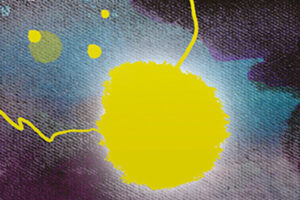Maggie Mackay reviews Sensitive to Temperature by Serena Alagappan (Smith|Doorstop Books, 2023)
In this Poetry Business New Poets prizewinning pamphlet of twenty poems, eco-poet Serena Alagappan calls our attention to the precarious condition of the Earth, and reveals our calling to nurture it. Hers is compact writing, and pulls a mighty spiritual punch about the interdependency of people and planet. Alagappan uses imagery of the natural world, of rocks and rivers, desert and water, and imbibes these with the full range of human emotion to subtle and devastating ends. She draws what needs to be written from deep waters, and plants seeds in our consciousness.
Alagappan is heavily influenced by poet and critic C.K. Williams’ philosophy that “beauty can save us from […] that paralysis that might keep us from doing what we can to confront what’s before us. The world is still ours to cherish and ours to protect”. Her project in Sensitive to Temperature is to show how our future depends on the planet being in balance, how we must cherish and protect it, and how human sorrow is firmly intertwined with environmental disaster.
I am reminded of a recent art exhibition, Our Plastic Ocean, at Dunfermline Carnegie Library & Galleries. Photographer Mandy Barker‘s images of discarded objects washed up on beaches and shorelines – from bottle caps and balloons to plastic bags, flip flops, footballs and packaging – are both beautiful and troubling. Scattered across dark black backdrops, these items of household waste take on a strange luminescence, like stars glowing in the night sky or sea creatures drifting in the current. Barker says, “For the past decade, I have researched and documented the impact of oceanic waste, combining art and science to raise awareness. I hope to inspire positive action in tackling this increasing environmental challenge which is of global concern”.
Hers is compact writing, and pulls a mighty spiritual punch about the interdependency of people and planet
In a favourite poem of mine, ‘The Sky Has a Body’, Alagappan engages the language of human behaviour to show the sky – the earth’s atmosphere – in crisis. Her stunning images draw empathy from me as a reader. Like a human being struggling with life-threatening respiratory problems, the sky “coughs / with smoke”, “runs a fever”, “wheezes with its wind, loses its / breath, belches thunder”. It weeps in the face of every kind of pollution. I think this poem holds more power than a lengthy scientific report. Alagappan shows how living things have to adjust to changing environments.
A run of poems develop the notion of the interconnectivity of human and planetary fate. ‘Clockwork’ explores the ability of geologists to “measure planetary dynamics”. ‘The Body keeps the Score’ looks at the struggle of rock, stone and sand against the perils of “filth and crisis”. The power in the verbs is palpable – “drags”, “tugged”, “catapult”. The images of chaos are relentless and pull at our senses. Earth’s vulnerabilities are laid bare. The world is fatigued, diseased. Its immune system is weakened, heart too, and allergies abound.
The title of the powerful poem ‘After the Mushroom at the End of the World’ immediately reminded me of the recent anniversary of the annihilation of Hiroshima and Nagasaki. The film Oppenheimer is currently in cinemas, bearing witness to the dropping of atom bombs resulting in devastating human and environmental consequences. The poem’s lament is a forewarning of the earth’s destiny, one of landfill, non-biodegradable plastic, garbage, and decay. Who are we kidding, she seems to imply, that all can be saved? The poem ends,
What’s left at the end of the world,
besides lichen, missile clouds blocking
the sun, and a harvest for two that
can only be tilled by one?
Following poems use the four elements – fire, wind, water, air – to press home a sense of impending catastrophe. ‘Slugs in a storm’ builds images of every kind of disharmony: torrents of water, twisting wind, fire tornado, storms. There’s a real sense of urgency, and even a sense of danger in the slugs’ sexual encounters. ’Red Moon’ seduced me with its title but speaks of war and pain, the vulnerabilities of earthly human connections and the tricky relationship “falling at God’s feet”. The poem offers hope in the remembrance of “the night in stained glass” and of a certainty of recovery from personal pain that will be “sharp, exploding, sure”. The tone changes again in ‘Nostalgia Architects’ which hails water memorials, the nurturing of trees, the historic recording of human existence with a dash of cynicism rather than angry energy:
So many memorials nurture trees:
Baby Callery pears, brought as saplings,
not seeds. Eight yellowwoods planted
in 1993 for the eight women etched
into the wall. Cherry blossoms,
which speckle a green space pink.
The title poem, ‘Sensitive to Temperature’, takes us to the Andes in South America in four three-line prose stanzas which mix lyricism with science. Alagappan describes frost which “reaps snow stuck so tight / flakes look like bones”. Glacial formations named penitentes after their resemblance to “inconsolable” pilgrims might likewise “move you to your knees”. Like these phenomena, we are all “frozen in numb rapture”. This is a sensitive and touching piece, particularly beautiful in its praise of “spires under a night sky” glinting like stars, and which are mirrored by icicles “reversed in their rising” hundreds of millions of miles away on a satellite of Jupiter.
Maggie Mackay‘s poetry has been published in many publications and anthologies. Her pamphlet The Heart of the Run was published by Picaroon Poetry in 2018 and her collection A West Coast Psalter by Kelsay Books in 2021. The Poetry Archive WordView 2020 awarded her poem ‘How to Distil a Guid Scotch Malt’ a place in the permanent collection. Her second collection, The Babel of Human Travel, was published in December 2022 by Impspired Press. She enjoys a whisky, a good jazz band, and daydreaming with her gorgeous rescue greyhound.

